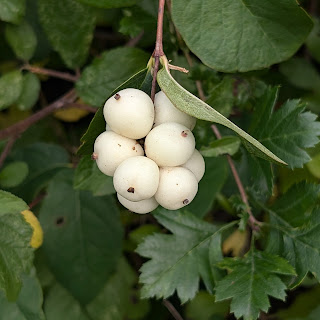School is on half term where I live, so I had a little horticulture helper with potting up two begonia maculata that I'd propagated by water (and left a bit too long) and potting on a Hawthoria that is desperate to expand.
01 November 2024
25 October 2024
Plant profile: Dahlias
Topics:
dahlia,
Plant Profile
Native to Mexico and Central America, dahlias have a rich history dating back to the Aztecs, who valued them for their medicinal and culinary properties. Their vibrant beauty captivated European explorers in the 18th century, leading to their introduction to European gardens in 1789. Since then, dahlias have become synonymous with elegance and have played a significant role in horticultural culture.
Botanically, dahlias are tuberous perennials belonging to the Asteraceae family. They exhibit a remarkable diversity of flower forms, ranging from simple singles to intricate pom-poms, and come in a kaleidoscope of colours, excluding blue. These stunning flowers thrive in sunny locations with well-draining soil, requiring regular watering and fertilisation to reach their full potential.
𝗗𝗮𝗵𝗹𝗶𝗮𝘀 𝗮𝗿𝗲 𝗮 𝗺𝗮𝗴𝗻𝗲𝘁 𝗳𝗼𝗿 𝗽𝗼𝗹𝗹𝗶𝗻𝗮𝘁𝗼𝗿𝘀, 𝗽𝗮𝗿𝘁𝗶𝗰𝘂𝗹𝗮𝗿𝗹𝘆 𝘃𝗮𝗿𝗶𝗲𝘁𝗶𝗲𝘀 𝘄𝗶𝘁𝗵 𝘀𝗶𝗺𝗽𝗹𝗲𝗿, 𝘀𝗶𝗻𝗴𝗹𝗲-𝗽𝗲𝘁𝗮𝗹 𝗮𝗿𝗿𝗮𝗻𝗴𝗲𝗺𝗲𝗻𝘁𝘀 𝘁𝗵𝗮𝘁 𝗽𝗿𝗼𝘃𝗶𝗱𝗲 𝗲𝗮𝘀𝘆 𝗮𝗰𝗰𝗲𝘀𝘀 𝘁𝗼 𝗻𝗲𝗰𝘁𝗮𝗿 𝗮𝗻𝗱 𝗽𝗼𝗹𝗹𝗲𝗻. 𝗕𝗲𝗲𝘀, 𝗯𝘂𝘁𝘁𝗲𝗿𝗳𝗹𝗶𝗲𝘀, 𝗮𝗻𝗱 𝗼𝘁𝗵𝗲𝗿 𝗯𝗲𝗻𝗲𝗳𝗶𝗰𝗶𝗮𝗹 𝗶𝗻𝘀𝗲𝗰𝘁𝘀 𝗮𝗿𝗲 𝗱𝗿𝗮𝘄𝗻 𝘁𝗼 𝘁𝗵𝗲𝘀𝗲 𝘃𝗶𝗯𝗿𝗮𝗻𝘁 𝗯𝗹𝗼𝗼𝗺𝘀, 𝗺𝗮𝗸𝗶𝗻𝗴 𝗱𝗮𝗵𝗹𝗶𝗮𝘀 𝗮𝗻 𝗶𝗻𝘃𝗮𝗹𝘂𝗮𝗯𝗹𝗲 𝗮𝗱𝗱𝗶𝘁𝗶𝗼𝗻 𝘁𝗼 𝗮𝗻𝘆 𝗽𝗼𝗹𝗹𝗶𝗻𝗮𝘁𝗼𝗿-𝗳𝗿𝗶𝗲𝗻𝗱𝗹𝘆 𝗴𝗮𝗿𝗱𝗲𝗻. For instance, the dahlia cultivar 'Bishop of Llandaff' with its bright red, single-petal blooms is a favourite among pollinators. Another popular choice is the 'Dahlia Inca' with its cheerful yellow petals and prominent central disc, which attracts a variety of bees and butterflies.
Beyond their horticultural appeal, dahlias have cultural significance, particularly in the Victorian era, where they symbolised dignity and instability. The popularity of dahlias led to a proliferation of cultivars and the establishment of dedicated flower shows, showcasing their stunning beauty. Today, dahlias remain a beloved floral choice for arrangements, weddings, and garden displays worldwide, admired for their vibrant colours, intricate forms, and historical significance.
05 October 2024
Plant Profile: 𝑺𝒏𝒐𝒘𝒃𝒆𝒓𝒓𝒚 - 𝑺𝒚𝒎𝒑𝒉𝒐𝒓𝒊𝒄𝒂𝒓𝒑𝒐𝒔 Symphoricarpos
Topics:
Plant Profile,
snowberry
Botanically, dahlias are tuberous perennials belonging to the Asteraceae family. They exhibit a remarkable diversity of flower forms, ranging from simple singles to intricate pom-poms, and come in a kaleidoscope of colours, excluding blue. These stunning flowers thrive in sunny locations with well-draining soil, requiring regular watering and fertilisation to reach their full potential.
𝗗𝗮𝗵𝗹𝗶𝗮𝘀 𝗮𝗿𝗲 𝗮 𝗺𝗮𝗴𝗻𝗲𝘁 𝗳𝗼𝗿 𝗽𝗼𝗹𝗹𝗶𝗻𝗮𝘁𝗼𝗿𝘀, 𝗽𝗮𝗿𝘁𝗶𝗰𝘂𝗹𝗮𝗿𝗹𝘆 𝘃𝗮𝗿𝗶𝗲𝘁𝗶𝗲𝘀 𝘄𝗶𝘁𝗵 𝘀𝗶𝗺𝗽𝗹𝗲𝗿, 𝘀𝗶𝗻𝗴𝗹𝗲-𝗽𝗲𝘁𝗮𝗹 𝗮𝗿𝗿𝗮𝗻𝗴𝗲𝗺𝗲𝗻𝘁𝘀 𝘁𝗵𝗮𝘁 𝗽𝗿𝗼𝘃𝗶𝗱𝗲 𝗲𝗮𝘀𝘆 𝗮𝗰𝗰𝗲𝘀𝘀 𝘁𝗼 𝗻𝗲𝗰𝘁𝗮𝗿 𝗮𝗻𝗱 𝗽𝗼𝗹𝗹𝗲𝗻. 𝗕𝗲𝗲𝘀, 𝗯𝘂𝘁𝘁𝗲𝗿𝗳𝗹𝗶𝗲𝘀, 𝗮𝗻𝗱 𝗼𝘁𝗵𝗲𝗿 𝗯𝗲𝗻𝗲𝗳𝗶𝗰𝗶𝗮𝗹 𝗶𝗻𝘀𝗲𝗰𝘁𝘀 𝗮𝗿𝗲 𝗱𝗿𝗮𝘄𝗻 𝘁𝗼 𝘁𝗵𝗲𝘀𝗲 𝘃𝗶𝗯𝗿𝗮𝗻𝘁 𝗯𝗹𝗼𝗼𝗺𝘀, 𝗺𝗮𝗸𝗶𝗻𝗴 𝗱𝗮𝗵𝗹𝗶𝗮𝘀 𝗮𝗻 𝗶𝗻𝘃𝗮𝗹𝘂𝗮𝗯𝗹𝗲 𝗮𝗱𝗱𝗶𝘁𝗶𝗼𝗻 𝘁𝗼 𝗮𝗻𝘆 𝗽𝗼𝗹𝗹𝗶𝗻𝗮𝘁𝗼𝗿-𝗳𝗿𝗶𝗲𝗻𝗱𝗹𝘆 𝗴𝗮𝗿𝗱𝗲𝗻. For instance, the dahlia cultivar 'Bishop of Llandaff' with its bright red, single-petal blooms is a favourite among pollinators. Another popular choice is the 'Dahlia Inca' with its cheerful yellow petals and prominent central disc, which attracts a variety of bees and butterflies.
Beyond their horticultural appeal, dahlias have cultural significance, particularly in the Victorian era, where they symbolised dignity and instability. The popularity of dahlias led to a proliferation of cultivars and the establishment of dedicated flower shows, showcasing their stunning beauty. Today, dahlias remain a beloved floral choice for arrangements, weddings, and garden displays worldwide, admired for their vibrant colours, intricate forms, and historical significance.
Subscribe to:
Posts (Atom)








